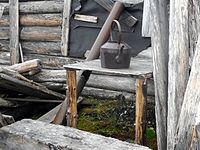Look at the traditional and old designs for niddy-noddys. They are STRONG, heavy, and clunky.
Why?
Modern designs of light weight PVC pipe or thin dowel, work very well --- as long as you are working with dry yarn.
So, why are the traditional designs so strong? I think they were also used for blocking skeins of yarn.
I think the old spinners, wound off their bobbins onto niddy-noddys, washed the yarn or steamed the yarn on the niddy-noddy, then let the yarn dry on the niddy-noddy, so that the skein of yarn was blocked when it came off the niddy-noddy. The yarn will try to shrink so the niddy-noddy must be strong to resist the contraction of the yarn.
That gives me a better blocked skein than taking the skeins off the niddy-noddys, washing the yarn, and trying to block the loose skein. I do not find that this works well. The better alternative taught today is to put the WET skein on the squirrel cage swift and wind it on to a yarn reel for blocking and drying. That does give a better product, but I am not sure that I need to work that hard.
One should not wet a niddy-noddy that has a varnished, or linseed oil finish. One will ruin the finish or discolor the wood.
However, niddy-noddys are (or can be) small and inexpensive. They can be made to disassembled for storage. A niddy-noddy holds about a #1 bobbin of yarn for washing/drying. If I am spinning 4 bobbins of yarn per day, then 16 niddy-noddys will give the skeins 3 days to dry, and 16 niddy-noddys take up less space and cost less than one yarn reel. The yarn reel is much better for dyed or sized yarn. However, skeins on niddy noddys can be dried in the microwave, which makes the process wicked fast.
Working with green wood, a wood worker with Iron Age tools could make 16 functional niddy noddys in a day. A 15th century wood worker with steel tools could make them in a couple of hours. I can buy PVC pipe and wood dowel at the hardware store around the corner and do the 16 in less than half an hour for a cost of less than $15. (the prototypes were made of maple with oak limbs, the limbs can be pushed through to release the skein. Thus the limbs can be either parallel for easy storage or the traditional orthogonal. )
For fines, I like my little reels. However, for 3,000 ypp warp and weft, I am going to give the niddy-noddys another chance. I will wind off on to the niddy-noddy, and the wash, rinse, and dry batches of skeins on their niddy-noddys.
If I do not use spinning oil, then I will steam the skein on the niddy noddy with my little electric fabric steamer that was so inexpensive. This sets the twist and the yarn drys quickly. I can imagine doing this with the steam from the spout of a large metal kettle hung over an open fire.
This would give a way for Old Time Spinners to set the twist of their product, and have it ready to pack and sell almost instantly even in damp weather, and to future archaeologists, it would look like a tea kettle.
Bronze Age textile workers were producing good cloth by the ship load. That tells me that they were blocking the yarn. They were blocking a lot of yarn. Any archaeologist that does not address the issue, does not have a clew. I think they had niddy noddys with a handle at one end ( see Alden Amos, Big Book of Handspinning, pg 447,343) wound the yarn onto the niddy noddy, and dipped the niddy noddy of yarn into a big kettle of hot or boiling water. Metal kettles would have been another way that the Bronze Age improved textile production. And, to future archaeologists it looks like a soup kettle. It was, but it may also have helped spinners earn their bread.
The reels are faster to wind onto, and dry faster, but after washing and drying, I have to wind off of the reels. The skeins on the niddy-noddys dry slower, but when they are dry, I have a blocked skein. I will use a squirrel cage swift to transfer the yarn to bobbins and pirns so that is extra effort. On the other hand for a weaving project, the skeins are easier to store. Managing the yarn as I spin the yarn for a weaving a bolt of cloth is different than managing the yarn to knit a pair of socks. Managing the yarn for a boat load of cloth.
If this does not work as well as I hope, then I must make a bunch of yarn reels that are tapered so that I can slide skeins/ hanks off, or simply sit the reels on their end, and use them as an end delivery yarn package.
In England, there have been laws against using niddy-noddys to measure yarn for sale for 400 years. In Chaucer's day, it really was a tool of the professional spinner. However, it is easy to wind yarn onto a niddy noddy so tightly that it stretches, thus, a skeiner gives a better measure of the length of the yarn. I think of the tons and tons of cloth that passed under Chaucer's nose, and the thousands of spinners that is took to spin the yarn for all that cloth. I think about the weavers being able to demand that the yarn be measured under less tension, and therefor that there be more yarn in a hank.
What I am saying is that textile historians really have not considered and discussed the practical details of how Old Time Textile Workers made boat loads of cloth. I am not sure they used niddy noddys, but at least I am thinking about the holes in the story.



.jpg)